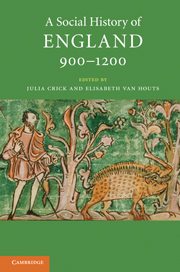Book contents
- Frontmatter
- Contents
- List of figures
- List of maps and tables
- List of contributors
- Acknowledgements
- List of abbreviations
- Map 1 England and its neighbours
- Map 2 England 900–1200
- I Introduction
- I.1 Land use and people
- I.2 Water and land
- I.3 Forest and upland
- I.4 Mineral resources
- I.5 Health and disease
- II.1 Authority and community
- II.2 Lordship and labour
- II.3 Order and justice
- II.4 War and violence
- II.5 Family, marriage, kinship
- II.6 Poor and powerless
- III.1 Towns and their hinterlands
- III.2 Commerce and markets
- III.3 Urban planning
- III.4 Urban populations and associations
- IV.1 Invasion and migration
- IV.2 Ethnicity and acculturation
- IV.3 Intermarriage
- IV.4 The Jews
- V.1 Religion and belief
- V.2 Rites of passage and pastoral care
- V.3 Saints and cults
- V.4 Public spectacle
- V.5 Textual communities (Latin)
- V.6 Textual communities (vernacular)
- VI.1 Learning and training
- VI.2 Information and its retrieval
- VI.3 Esoteric knowledge
- VI.4 Medical practice and theory
- VI.5 Subversion
- Glossary
- Time line 900–1200
- Further reading
- Index
- References
I.2 - Water and land
Published online by Cambridge University Press: 05 June 2012
- Frontmatter
- Contents
- List of figures
- List of maps and tables
- List of contributors
- Acknowledgements
- List of abbreviations
- Map 1 England and its neighbours
- Map 2 England 900–1200
- I Introduction
- I.1 Land use and people
- I.2 Water and land
- I.3 Forest and upland
- I.4 Mineral resources
- I.5 Health and disease
- II.1 Authority and community
- II.2 Lordship and labour
- II.3 Order and justice
- II.4 War and violence
- II.5 Family, marriage, kinship
- II.6 Poor and powerless
- III.1 Towns and their hinterlands
- III.2 Commerce and markets
- III.3 Urban planning
- III.4 Urban populations and associations
- IV.1 Invasion and migration
- IV.2 Ethnicity and acculturation
- IV.3 Intermarriage
- IV.4 The Jews
- V.1 Religion and belief
- V.2 Rites of passage and pastoral care
- V.3 Saints and cults
- V.4 Public spectacle
- V.5 Textual communities (Latin)
- V.6 Textual communities (vernacular)
- VI.1 Learning and training
- VI.2 Information and its retrieval
- VI.3 Esoteric knowledge
- VI.4 Medical practice and theory
- VI.5 Subversion
- Glossary
- Time line 900–1200
- Further reading
- Index
- References
Summary
INTRODUCTION
Water, in its various forms, is one of the character-defining features of Britain's landscape. Its coast is heavily indented with estuaries that allow tidal waters to penetrate far inland, and the rivers that flow into these estuaries first cross low-lying floodplains whose permanently high water tables and vulnerability to flooding make them challenging yet ecologically productive environments in which to live. Many of these estuaries, and some stretches of open coastline, are also fringed by low-lying wetlands, mostly derived from the reclamation of what were once intertidal salt marshes, and in total wetlands once covered 8.4 per cent of England. In the prehistoric period these various wetlands formed a mosaic of natural environments including unvegetated intertidal mudflats around the coasts and estuaries that were covered by the sea twice a day, and more elevated areas of mud – known as salt marshes – that had been colonized by salt-tolerant plants and may have been flooded only a few times a month at the higher spring tides. In the more extensive coastal wetlands the deposition of sediment on these marshes meant that they built up to such a height that the sea no longer reached the inland areas, or ‘backfens’, where freshwater peatlands developed with a range of vegetation including reeds, sedges, alder-carr woodland and sphagnum moss.
- Type
- Chapter
- Information
- A Social History of England, 900–1200 , pp. 38 - 45Publisher: Cambridge University PressPrint publication year: 2011



